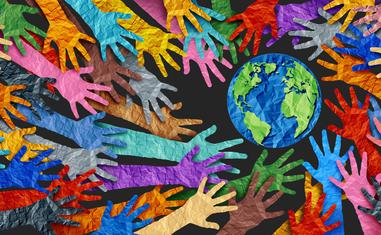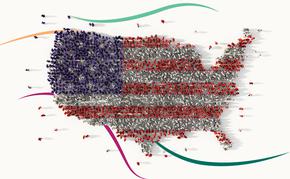The views expressed in our content reflect individual perspectives and do not represent the authoritative views of the Baha'i Faith.
Here’s a hard question: in this life, should we exert our efforts to serve humanity hyper-locally, with the people we’re in direct contact with; or should we focus on larger, more global concerns?
This theme runs throughout good literature and film. One such movie is Downsizing, starring Matt Damon.
On its surface, Downsizing seems only to offer a funny and quirky story of the lives of people who have been miniaturized, reminiscent of the 80s film Honey, I Shrunk the Kids. However, Downsizing has much more to offer, with commentary on social and environmental issues as well as our ultimate purpose in life. (Spoiler alert! If you haven’t already seen the movie, you might want to do that first before reading this article.)
RELATED: Surviving and Thriving, Despite the Chaotic Forces of Modern Life
As the film opens, Paul Safranek and his wife Audrey make the unchangeable decision to be “downsized” – miniaturized through a recently developed technology. However, after Paul awakens from the procedure, he finds out that his wife chose to stay regular-sized and hence they get divorced.
After settling into his new but smaller life, Paul meets a woman with one leg who escaped persecution in Vietnam, Ngoc Lan. Trained in occupational therapy, Paul accompanies Ngoc Lan to her home to adjust her prosthetic leg. There he discovers a dilapidated building outside the protective walls of the downsized community where people are hungry and ill. Ngoc Lan takes food and medicine to these suffering people on a daily basis, which she salvages from the homes she cleans during the day.
As the story unfolds, Paul and Ngoc Lan both end up on a trip to Norway to visit the original downsized community, a group of scientists, activists, and rebels who live their lives in defiance of the consumerist world-society. There, Paul and Ngoc Lan discover that the recent news of arctic methane emissions is true – and that the end of the world is coming. They also learn that the downsized community has a survival plan, a chamber deep under the Earth with a complete ecosystem of its own where the community will retreat to and perpetuate itself for some 8,000 years until the Earth’s surface becomes habitable again.
Now Paul faces a difficult decision: join with the survivalists who will continue the human race underground; or stay with the woman he has come to love, Ngoc Lan, and go back to a doomed world and continue to help others. After deciding and starting his long journey down the underground tunnel, Paul has a change of heart – he goes back with Ngoc Lan to their life in the US for however long it may continue. After arriving, he works side by side with her in attending to the sick and hungry of the impoverished community. The film asks us this question: did he make the right decision?
To answer it, we need to think of the nature of each endeavor. On the one hand, the subterranean community in Norway aims for the long-term. They have used their faculty of reason to make a systematic plan that will enable the human race to survive. They have not let feelings of sentimentality cloud their vision, but have relied on logic and science to lead the way, guided by a deep sense of responsibility, of course.
On the other hand, Ngoc Lan is guided by love and compassion – by her heart. She cares about the immediate needs of the people around her in her day-to-day life. She doesn’t look ahead to an unknown future; instead she lives very much in the here and now with her heart centered on helping others.
Is either of these endeavors superior to the other?
Years ago someone told me that there is no sense in trying to attend to the hungry and needy because Band-Aid solutions don’t address the root causes of the problem. Instead, what needs to happen is a complete change in the structure of society – and that is where we need to place all of our attention.
At the level of logic, this did make sense to me. But deeper down it didn’t sit right. On the other hand, to rely on love alone, without any systemization, also seemed incomplete.
Now I see it all differently – I see that both approaches are complementary. Systematization is indispensable. Yes, to attend to the world’s problems we need to look at the underlying issues and build new foundations. This is a long process, and requires the use of foresight and planning.
However, if this approach is used to the exclusion of a compassionate response to the problems in the present, it runs the risk of being devoid of caring and even heartless. The very purpose it sets out to achieve will be lost, because there is no life pulsating through it.
The Baha’i teachings offer a unified solution to these divergent approaches. Baha’u’llah has revealed a world-changing order, which Baha’is believe will completely transform human life in the long run. He wrote:
The world’s equilibrium hath been upset through the vibrating influence of this most great, this new World Order. Mankind’s ordered life hath been revolutionized through the agency of this unique, this wondrous System — the like of which mortal eyes have never witnessed.
So the world’s Baha’is are at work building the spiritual and practical foundations for that new order.
But this is not the job of a cold-hearted technician who turns a blind eye to suffering. Lovingly attending to suffering is part and parcel of building that new world order. A future world of peace and love cannot be built on logic and logistics alone, it must also be built on peace and love. For love to be real it must be tried and tested, manifested in concrete actions in the here and now. This is why the Baha’i plan to change our reality stretches from the level of global administration right down to the level of grassroots action driven by compassion and caring.
So did Paul make the right choice at the end of Downsizing? Perhaps the place he ended up wasn’t important. Whether he retreated under the Earth or stayed above – a thoughtful symbol of engaging with the pain of humanity or withdrawing from it – was far less important than the motivation behind his choice. Was he motivated by love for others? That’s the important thing.
RELATED: We Must Face the Risks to the World’s Future – Now
However, what’s different for us outside the scenario of this movie is that we don’t have to face this decision of choosing to contribute to long-term peace and addressing the issues around us right now. For us, this is a false dichotomy that we don’t need to draw. We can dedicate our efforts to the long-term and to the world around us right now.
To do this, there are certain things we need to remember. To aim long-term, we do need to reflect, plan, and act systematically. If we don’t, our efforts will be scattered and the just and peaceful world we are trying to build will remain remote. At the same time, in dedicating ourselves to systematic action, we cannot ignore the significance of the human needs that cry out for our attention all around us. Every day, there are people with problems that need our love and care. After looking at our grand world-changing plan, these things may seem trivial and a waste of our precious time. But when we look a bit closer, we will see that these supposedly “petty” problems around us form the very stepping stones on which the future world is built.
Abdu’l-Baha, the son and successor of Baha’u’llah, occupies a special station in the Baha’i Faith. Although he was not a prophet or a messenger of God like Baha’u’llah, his exemplary life serves as the role model for the lives of all Baha’is. He perfectly combined a long-term vision for the rebuilding of human society into a justice-centered, peace-promoting global civilization; and the love and kindness exemplified by daily service to those in need. This quotation from Abdu’l-Baha’s writings describes that exquisite balance we can all strive for:
Be thou a summoner to love, and be thou kind to all the human race. Love thou the children of men and share in their sorrows. Be thou of those who foster peace. Offer thy friendship, be worthy of trust. Be thou a balm to every sore, be thou a medicine for every ill. Bind thou the souls together. Recite thou the verses of guidance. Be engaged in the worship of thy Lord, and rise up to lead the people aright.

















Comments
Sign in or create an account
Continue with Facebookor